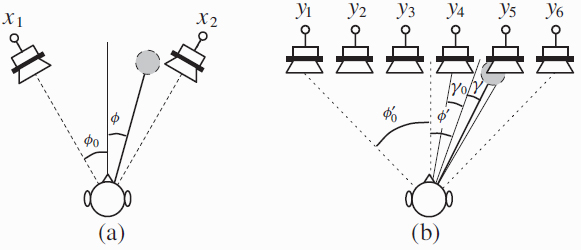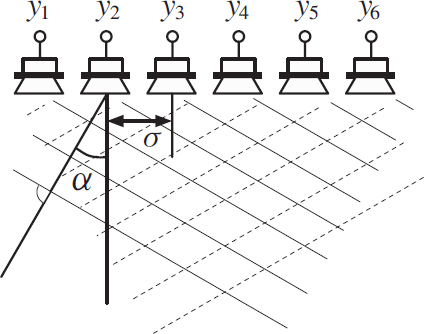10.4 Reproduction using different rendering setups
Given the spatial decomposition of the stereo signal, i.e. the sub-band signals for the estimated localized direct sound ŝ′m, the factor Ab, and the lateral independent signals n1,m and ![]() ′2,m, one can define rules on how to emit the signal components corresponding to ŝ′m,
′2,m, one can define rules on how to emit the signal components corresponding to ŝ′m, ![]() ′1,m, and
′1,m, and ![]() ′2,m from different playback setups.
′2,m from different playback setups.
10.4.1 Multiple loudspeakers in front of the listener
Figure 10.8 illustrates the scenario that is addressed. The virtual sound stage of width ϕ0 = 30°, shown in Part (a) of the figure, is scaled to a virtual sound stage of width ϕ0 which is reproduced with multiple loudspeakers, shown in part (b) of the figure.
Figure 10.8 The ±30° virtual sound stage (a) is converted to a virtual sound stage with the width of the aperture of a loudspeaker array (b).
The estimated independent lateral sound, ![]() ′1,m and
′1,m and ![]() ′2,m, is emitted from the loudspeakers on the sides, e.g. loudspeakers 1 and 6 in Figure 10.8(b). That is, because the more the lateral sound is emitted from the side the more it is effective in terms enveloping the listener into the sound [201]. Given the estimated factor Ab, the angle ϕb of the auditory object in parameter band b relative to the ±ϕ0 virtual sound stage is estimated, using the ‘stereophonic law of sines’ [11],
′2,m, is emitted from the loudspeakers on the sides, e.g. loudspeakers 1 and 6 in Figure 10.8(b). That is, because the more the lateral sound is emitted from the side the more it is effective in terms enveloping the listener into the sound [201]. Given the estimated factor Ab, the angle ϕb of the auditory object in parameter band b relative to the ±ϕ0 virtual sound stage is estimated, using the ‘stereophonic law of sines’ [11],

Alternatively, other panning laws, such as the stereophonic law of tangents, may be used. The obtained angle is linearly scaled to compute the angle relative to the widened sound stage,
![]()
The loudspeaker pair enclosing ϕ′b is selected. In the example illustrated in Figure 10.8(b) this pair has indices 4 and 5. The angles relevant for amplitude panning between this loudspeaker pair, γ0 and γ, are defined as shown in the figure. If the selected loudspeaker pair has indices l and l + 1 then the signals given to these loudspeakers are

where the amplitude panning factors a1,b and a2,b are computed with the stereophonic law of sines and normalized such that a21,b + a22,b = 1

Figure 10.9 Loudspeaker pair selection l (top) and factors a1,b and a2,b are shown as a function of the stereo signal level difference px2,b/px1,b.
with
![]()
The factors ![]() in Equation (10.22) are such that the total power of these signal is equal to the total power of the coherent components, sm and Absm, in the stereo signal.
in Equation (10.22) are such that the total power of these signal is equal to the total power of the coherent components, sm and Absm, in the stereo signal.
Figure 10.9 shows an example for the selection of loudspeaker pairs, l and l + 1, and the amplitude panning factors a1,b and a2,b for ϕ0 = ϕ0 = 30° for I = 8 loudspeakers at angles {−30°, −20°, −12°, −4°,4°,12°,20°,30°}.
Given the above reasoning, each time–frequency tile of the output signal channels is computed as

where

and i is the output channel index 1 ≤ i ≤ I. The sub-band signals of the output channels are converted back to the time domain and form the output channels y1 to yI. In the following, this last step is not always explicitly mentioned again.
Figure 10.10 Alternatively, ĥ′1 and ĥ′2 are emitted as two plane waves emitted with angles ±α.
A limitation of the scheme described is that when the listener is at one side, e.g. close to loudspeaker 1, the lateral independent sound will reach him with much more intensity than the lateral sound from the other side. This problem can be circumvented by emitting the lateral independent sound from all loudspeakers with the aim of generating two lateral plane waves. This is illustrated in Figure 10.10. The lateral independent sound is given to all loudspeakers with delays mimicking a plane wave with a certain direction,

where db is the delay,
![]()
σ is the distance between the equally spaced loudspeakers (in meters), v is the speed of sound (in meters per second), fs is the sub-band sampling frequency (in Hertz), and ±αb are the directions of propagation of the two plane waves.
10.4.2 Multiple front loudspeakers plus side loudspeakers
The previously described playback scenario aims at widening the virtual sound stage and at making the perceived sound stage independent of the location of the listener.
Optionally one can play back the independent lateral sound, ![]() ′1,m and
′1,m and ![]() ′2,m, with two separate loudspeakers located more to the sides of the listener, as illustrated in Figure 10.11. It is expected that this results in a stronger impression of listener envelopment. In this case, the output signals are also computed by Equation (10.25), where the signals with index 1 and I are the loudspeakers on the side. The loudspeaker pair selection, l and l + 1, is in this case such that ŝ′m is never given to the signals with index 1 and I since the whole width of the virtual stage is projected to only the front loudspeakers 2 ≤ i ≤ I − 1.
′2,m, with two separate loudspeakers located more to the sides of the listener, as illustrated in Figure 10.11. It is expected that this results in a stronger impression of listener envelopment. In this case, the output signals are also computed by Equation (10.25), where the signals with index 1 and I are the loudspeakers on the side. The loudspeaker pair selection, l and l + 1, is in this case such that ŝ′m is never given to the signals with index 1 and I since the whole width of the virtual stage is projected to only the front loudspeakers 2 ≤ i ≤ I − 1.
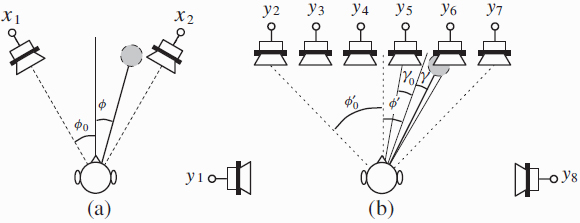
Figure 10.11 The ±30° virtual sound stage (a) is converted to a virtual sound stage with the width of the aperture of a loudspeaker array (b). Additionally, the lateral independent sound is played from the sides with separate loudspeakers for a stronger listener envelopment.
Figure 10.12 shows an example for the eight signals generated for the setup shown in Figure 10.11 for the same music clip for which the spatial decomposition was shown in Figure 10.7. Note that the dominant singer in the center is amplitude panned between the center two loudspeaker signals, y4 and y5.
10.4.3 Conventional 5.1 surround loudspeaker setup
One possibility to convert a stereo signal to a 5.1 surround compatible multi-channel audio signal is to use a setup as shown in Figure 10.11(b) with three front loudspeakers and two rear loudspeakers arranged as specified in the 5.1 standard. In this case, the rear loudspeakers emit the independent lateral sound, while the front loudspeakers are used to reproduce the virtual sound stage. Informal listening indicates that, when playing back audio signals as described, listener envelopment is more pronounced compared with stereo playback.
Another possibility to convert a stereo signal to a 5.1 surround compatible signal is to use a setup as shown in Figure 10.8 where the loudspeakers are rearranged to match a 5.1 configuration. In this case, the ±30° virtual stage is extended to a ±110° virtual stage surrounding the listener.
10.4.4 Wavefield synthesis playback system
First, signals are generated similar as for a setup as is illustrated in Figure 10.11(b). Then, I virtual sources are defined in the wavefield synthesis system. The lateral independent sound, y1 and yI, is emitted as plane waves or sources in the far field as is illustrated in Figure 10.13 for I = 8. For each other signal, a virtual source is defined with a location as desired. In the example shown in Figure 10.13, the distance is varied for the different sources and some of the sources are defined to be in the front of the sound emitting array, i.e. the virtual sound stage can be defined with an individual distance for each defined direction.
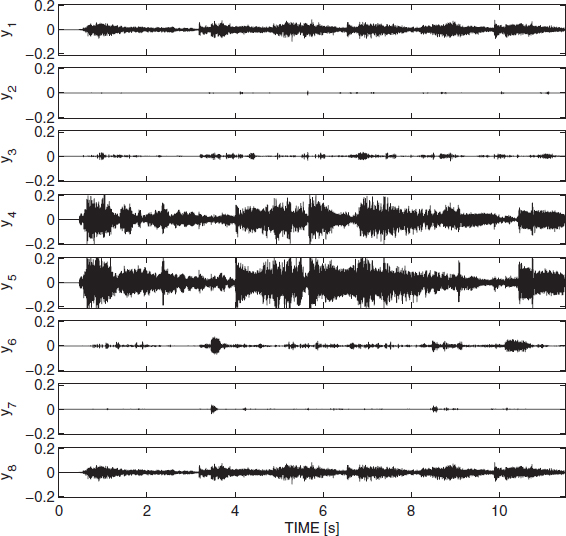
Figure 10.12 The eight signals, generated for a setup as in Figure 10.11(b), are shown.
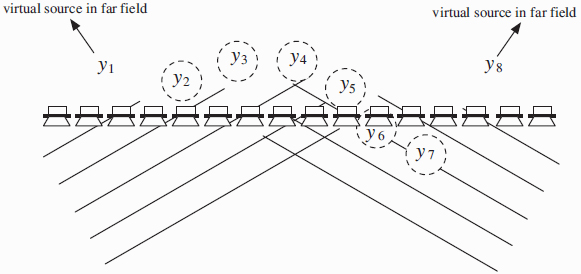
Figure 10.13 Each signal corresponding to the front sound stage is defined as a virtual source. The independent lateral sound is emitted as plane waves (virtual sources in the far field).
10.4.5 Modifying the decomposed audio signals
Controlling the width of the sound stage
By modifying the estimated scale factors, e.g. Ab, one can control the width of the virtual sound stage. By linear scaling with a factor larger than one, the instruments being part of the sound stage are moved more to the side. The opposite can be achieved by scaling with a factor smaller than one. Alternatively, one can modify the amplitude panning law Equation (10.20) for computing the angle of the direct localized sound.
Modifying the ratio between direct localized sound and the independent sound
For controlling the amount of ambience one can scale the independent lateral sound signals ![]() ′1 and
′1 and ![]() ′2 for getting more or less ambience. Similarly, the localized direct sound can be modified in strength by means of scaling the ŝ′ signals.
′2 for getting more or less ambience. Similarly, the localized direct sound can be modified in strength by means of scaling the ŝ′ signals.

